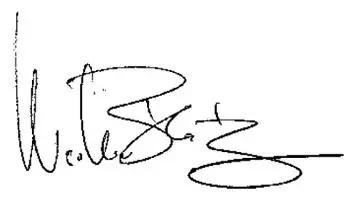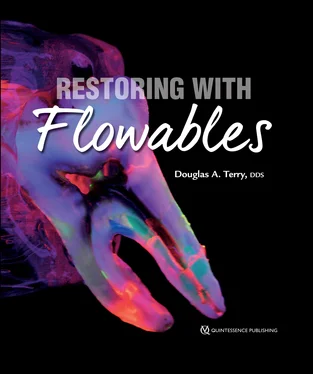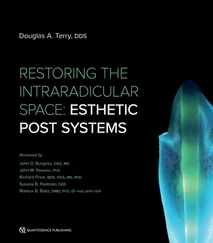Repairing the Fractured Denture Tooth
Replacing the Missing Denture Tooth
Developing a Functional Composite Prototype and Definitive Restoration
Restoring Occlusal Wear at the Interface
Developing the Anterior Prototype
Restoring Anterior Primary Teeth with Injectable Composite Crowns
Restoring a Posterior Primary Tooth with an Injectable Composite Crown
Restoring Function
Developing the Functional Composite Prototype
Reveneering with Resin Composite
Mandibular Anterior Composite Veneers
Restoring Anatomical Form
Composite Cutback Technique
 Developing a Post and Core
Developing a Post and Core
Restoring Function and Incisal Wear
Establishing Incisal Edge Position Prior to Crown Lengthening
 Resin-Bonded Bridge (Indirect Restoration)
Resin-Bonded Bridge (Indirect Restoration)
Developing Form, Contour, and Incisal Edge Position
 Video content
Video content
Extra video content is available online. A thumbnail of the QR code is shown next to any case that has video content. Scan the QR code here to access this supplementary information. The full list of videos may also be found at www.quintpub.com/Flowables.
Foreword
“The important thing is not to stop questioning. Curiosity has its own reason for existing… Never lose a holy curiosity.”
With these words, Albert Einstein encourages us to use our imagination and intuition to push the boundaries of the commonly accepted and create real progress.
For as long as I have known Douglas Terry, he has always followed that mantra, never satisfied with the status quo and continuously elevating dental care to new heights of clinical excellence.
This book presents such innovative concepts in a most comprehensive and invigorating manner. The incredible breadth of clinical applications of modern flowable composites, especially in combination with a novel injection technique, is demonstrated in such a compelling manner that it calls into question the validity of many “traditional” treatment concepts and materials.
While the existing evidence from a material science standpoint is convincing and supportive of the increased use of flowable composite materials in everyday clinical practice, the clinical simplicity, versatility, and longevity of the techniques described make them a true alternative to conventional protocols and restorative materials.
In addition to exceptional clinical documentation, one of the reasons Douglas’s books stand out in the dental literature and are so popular among clinicians and researchers alike is his unique ability to tell a compelling story. You will be drawn into the journey, starting with the fundamentals of adhesive dentistry and flowable composites and finishing with a variety of clinical applications and techniques you probably never even thought about. The level of detail Douglas provides from both scientific and clinical standpoints is astonishing, but it is never overwhelming due to his fluid and captivating writing style that keeps you reading and learning. In this book he has teamed up with the most renowned researchers and clinicians to distill the critical scientific and clinical information into a comprehensible and visually fascinating message. Whether you are a dental student or a most seasoned clinician or scientist, this book will open a new world to you and spur your curiosity in an unprecedented manner. “Never lose a holy curiosity!”

Markus B. Blatz, DMD, PhD, Dr med dent habil
Professor and Chair, Department of Preventive and Restorative Sciences, Penn Dental Medicine
President, International Academy for Adhesive Dentistry
Preface
In the past two decades, dentistry has witnessed a paradigm shift in philosophy that has been guided by a greater understanding of science. Advancements in restorative material formulations and adhesive technology have expanded the treatment possibilities for the patient, clinician, and technician. These advances have increased the myriad of opportunities available to discriminating patients and provided solutions to many of the restorative and esthetic challenges faced by the restorative team. This changing technology has also allowed the clinician to treat many esthetic and restorative challenges through more simple, conservative, and economical methods. This evolution in philosophy and science has resulted in a change in the trend for dental treatment.
Natural esthetics can be perplexing; observation of nature confirms this. The infinite forms and colors and all of their combinations are unlimited. The observation of sunrise with its many different colors reminds us that there is a lack of language to describe the beauty and essence that nature creates. In dentistry, natural esthetics should not be defined by but related to beauty, health, and harmony. Developing natural esthetics requires emotion, experience, judgment, observation, and imagination. Many times our interpretation is clouded by our own definitions and limited experiences. We must go back to our inherent senses to create only a shadow of the true essence of natural esthetics. Formulas and principles are necessary for the development of restorations, but they cannot become the only guiding light. It also requires an anatomical morphologic thinking of the individual characteristics of teeth through continued observation of intraoral and extracted teeth. In addition, the personalities of our patients and the importance of their individuality determine natural esthetics. Each patient, like each sunrise, is always unique and exciting.
I hope that every clinician and technician who reads these pages finds the excitement and fulfillment I have experienced from the pursuit of excellence in dentistry. Although there are different mediums to restore the natural dentition, this book focuses on the use of flowable resin composites to develop natural esthetic restorations. From my travels and hands-on courses around the world, I have realized that this restorative medium has a universal significance. It is not a solution to all restorative considerations, but it can offer an avenue for understanding natural esthetics while providing solutions to many restorative and esthetic challenges. Many clinicians think of restorative materials as a replacement of tooth structure, and composite restorations allow the clinician to understand the importance of the color of the substrate, the optical properties of light, the different restorative materials and their thickness and how this influences color, and even the difference in refractive indices of the materials to tooth structure and how they interrelate. It is by having an understanding of the dimensions of color and developing our senses through observation of nature that we can begin to create more lifelike restorations. We can begin to appreciate and understand the important role of technicians and the information that they need to create natural esthetic restorations on stone models without faces.
During my career in dentistry, I have researched in the laboratory and chairside, investigated resin composites, and worked with scientists, clinicians, and technicians around the world to develop techniques and materials with different hybrid composites to create natural esthetics. Many years ago, with the influence of Dr Vincenzo Musella and his inverse layering technique, I began a journey with flowable resin composites. Although the initial formulations were disappointing, at that same time, Dr John Burgess and Dr John Powers began studies with a new generation of universal flowables that showed promise. The clinical results in this book are a compilation of my endeavors. At the 3-year point, I was calling the restorations developed with the injectable technique transitional restorations. However, after discussions with Burgess and Powers regarding their clinical and laboratory findings with highly filled flowable resin composites, I learned that these restorations should be considered part of the armamentarium that the clinician can use in everyday practice.
Читать дальше

 Developing a Post and Core
Developing a Post and Core










